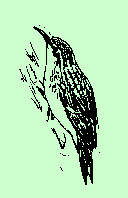|







|
. |
The Brown Creeper
 Certhia familiaris
Certhia familiaris

 The family name of the Brown Creeper (Certhiidae), means "tree
creeper". It is a slim, well-camouflaged, brown-backed bird, smaller
(5 - 6 inches) than a House Sparrow, with a slender decurved bill. Its tail
has stiff, pointed feathers which serve as braces in climbing. The strong
feet are armed with long curved claws which, though appearing delicate,
affort a firm grip on the bark of tree trunks.
The family name of the Brown Creeper (Certhiidae), means "tree
creeper". It is a slim, well-camouflaged, brown-backed bird, smaller
(5 - 6 inches) than a House Sparrow, with a slender decurved bill. Its tail
has stiff, pointed feathers which serve as braces in climbing. The strong
feet are armed with long curved claws which, though appearing delicate,
affort a firm grip on the bark of tree trunks.

 This creeper is brown above and streaked lengthwise with white. Two wide,
whitish bars cross each wing. The rump is light, rusty red. Beneath, from
bill to tail, it is white. The sexes are similar.
This creeper is brown above and streaked lengthwise with white. Two wide,
whitish bars cross each wing. The rump is light, rusty red. Beneath, from
bill to tail, it is white. The sexes are similar.

 Creepers favor mature forests and swamps with heavy undergrowth and dead
trees with loose bark. They nest in northern forests and spread out in
fall migration, which is usually in October. During this period they may
be seen in the shade trees of parks, lawns and street sides. Some may
remain all winter; many will go as far south as the Gulf of Mexico, then
return about April to breeding areas.
Creepers favor mature forests and swamps with heavy undergrowth and dead
trees with loose bark. They nest in northern forests and spread out in
fall migration, which is usually in October. During this period they may
be seen in the shade trees of parks, lawns and street sides. Some may
remain all winter; many will go as far south as the Gulf of Mexico, then
return about April to breeding areas.

 The creeper's nest, ordinarily placed behind a loose strip of bark, is
constructed of twigs, bark, dried grass, cobwebs, and plant-down; and lined
with very fine fibers such as shreds of inner bark from dead cedars. One
nest was found in a dead maple tree, three feet above the water in a swamp.
The eggs, white with a few brown specks, are very small and may be six to
nine in number. T. Gilbert Pearson writes, "When newly hatched, they are
tiny creatures with a covering of blackish natal down. When grown and out
of the nest, they appear to stay with the old birds for a time, and I have
seen whole families in late June creeping about the tree trunks in their
characteristic way."
The creeper's nest, ordinarily placed behind a loose strip of bark, is
constructed of twigs, bark, dried grass, cobwebs, and plant-down; and lined
with very fine fibers such as shreds of inner bark from dead cedars. One
nest was found in a dead maple tree, three feet above the water in a swamp.
The eggs, white with a few brown specks, are very small and may be six to
nine in number. T. Gilbert Pearson writes, "When newly hatched, they are
tiny creatures with a covering of blackish natal down. When grown and out
of the nest, they appear to stay with the old birds for a time, and I have
seen whole families in late June creeping about the tree trunks in their
characteristic way."

 In feeding, the Brown Creeper climbs up the tree trunks in little jumps or
hitches. It begins about two feet from the ground and examines the cracks
and crevices of the bark, moving spirally up the tree, then flying to the
base of another. Their food habits need further study, but based on the
contents of the few stomachs examined, they eat insect eggs and larvae,
small insects, spiders, small Hymenoptera and some small seeds, as of
scrub pines and panicgrass.
In feeding, the Brown Creeper climbs up the tree trunks in little jumps or
hitches. It begins about two feet from the ground and examines the cracks
and crevices of the bark, moving spirally up the tree, then flying to the
base of another. Their food habits need further study, but based on the
contents of the few stomachs examined, they eat insect eggs and larvae,
small insects, spiders, small Hymenoptera and some small seeds, as of
scrub pines and panicgrass.

 The call notes are thin and high-pitched, with an occasional warbling song
suggestive of a wren. William Brewster, who studied the creepers much
during the nesting season, wrote: "Though one of the sweetest that ever
rises in the thickets of the northern forests, it is never a very
conspicuous song. This is due to the fact that the song is short and by
no means powerful, but its tones are so exquisitely pure and tender that
I have never heard it without a desire to linger in the vicinity until
it has been many times repeated. It consists of a bar of four notes, the
first of moderate pitch, the second lower and less emphatic, the third
rising again, and the last abruptly falling, but dying away in an
indescribably plaintive cadence like the soft sigh of the wind among the
pine boughs. I can compare it to no other bird voice that I have ever heard."
The call notes are thin and high-pitched, with an occasional warbling song
suggestive of a wren. William Brewster, who studied the creepers much
during the nesting season, wrote: "Though one of the sweetest that ever
rises in the thickets of the northern forests, it is never a very
conspicuous song. This is due to the fact that the song is short and by
no means powerful, but its tones are so exquisitely pure and tender that
I have never heard it without a desire to linger in the vicinity until
it has been many times repeated. It consists of a bar of four notes, the
first of moderate pitch, the second lower and less emphatic, the third
rising again, and the last abruptly falling, but dying away in an
indescribably plaintive cadence like the soft sigh of the wind among the
pine boughs. I can compare it to no other bird voice that I have ever heard."

 The habitat of the brown creeper is being destroyed. When the habitat is
gone, the birds will be missing also. Do you realize how many beautiful,
local wooded areas have been bull-dozed and black-topped for buildings and
parking sites? How many swamps have been filled in the name of progress?
How many birds, especially the insect-eaters, have been destroyed by the
careless use of insecticides? How long will a variety or species of birds
survive this man-made destruction?
The habitat of the brown creeper is being destroyed. When the habitat is
gone, the birds will be missing also. Do you realize how many beautiful,
local wooded areas have been bull-dozed and black-topped for buildings and
parking sites? How many swamps have been filled in the name of progress?
How many birds, especially the insect-eaters, have been destroyed by the
careless use of insecticides? How long will a variety or species of birds
survive this man-made destruction?
-- by Marie L. Atkinson
|
|

